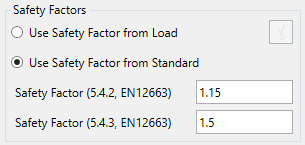DVS 1608 and 1612
DVS 1608 (June 2010) – design and strength assessment of welded structures from aluminium alloys in railway applications. DVS 1612 (August 2014) – design and endurance strength assessment Of welded joints with Steels in rail vehicle construction.
To add DVS 1608 and 1612 standard execute from the ribbon:
![]()
Press  to Set Standard Custom Settings
to Set Standard Custom Settings
Use Hot Spot Stress - use Hot Spot Stress results for locations defined in Weld Finder Tool or Weld Stress results in the fatigue checks.
Aluminum Fatigue
Stress Concept - use Nominal Stress Concept (Chapter 7.2) or Notch Stress Concept (Chapter 7.3).
Notch Line Type - fatigue strength value for a maximum of 10 million load cycles (Appendix C).
Detail Production Type - castings or sheets/profiles/forgings (Chapter 7.2.1).
Breaking Elongation - Chapter 7.2.1, Table 4.
Bonus Factor - for low residual stress arises by increasing the medium voltage sensitivity (Chapter 7.1.1).
Grinded Welds - as a measure to improve the fatigue strength by subsequent processing of the welding seam transition is recommended. In this case, the fatigue strength value must be increased by 30% (factor 1.3).
Nominal Stress Phase - the factor considers the phase of the normal stresses to each other and can assume values between [-1; 1] (Chapter 7.1.4).
Steel Fatigue
Material Type - Steel S235 or S355 (Tables 4.1-4.2).
Line Slope of Notch - Weld Type from Annex B.
Safety Factors
Safety factors for static stress calculations can be used as constant values from EN 12663 standard or from Individual Loads and Load Sets:

Standard uses material data (Yield/Tensile) in calculations. Wizard checks if the values are defined for all materials.
